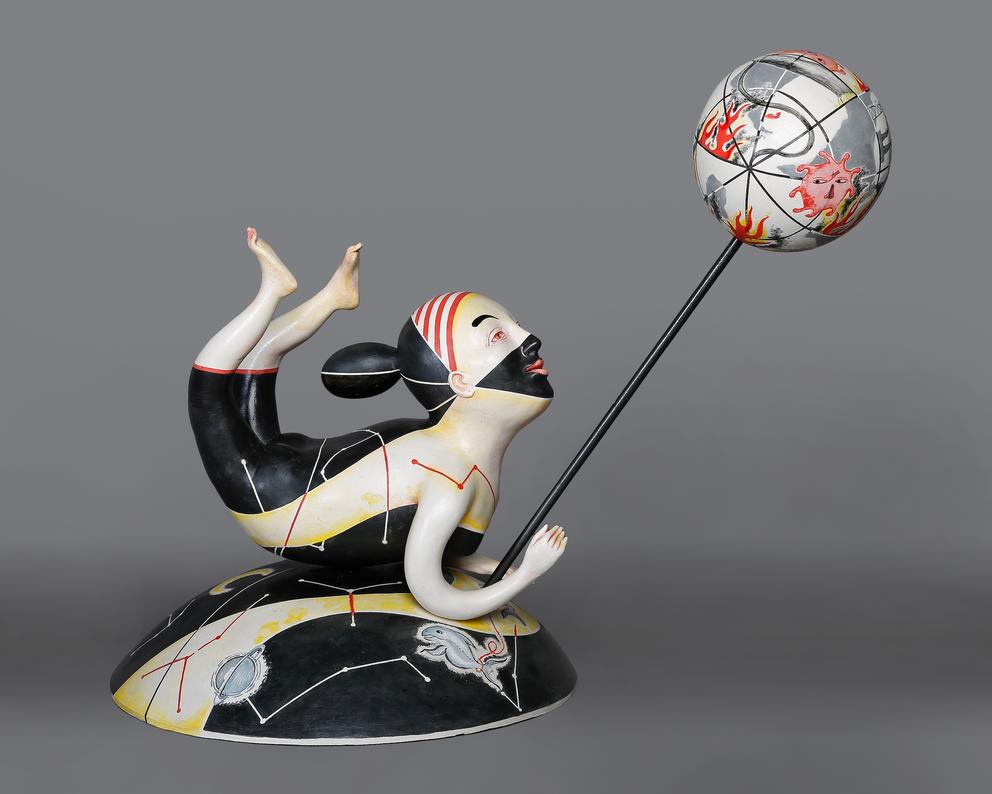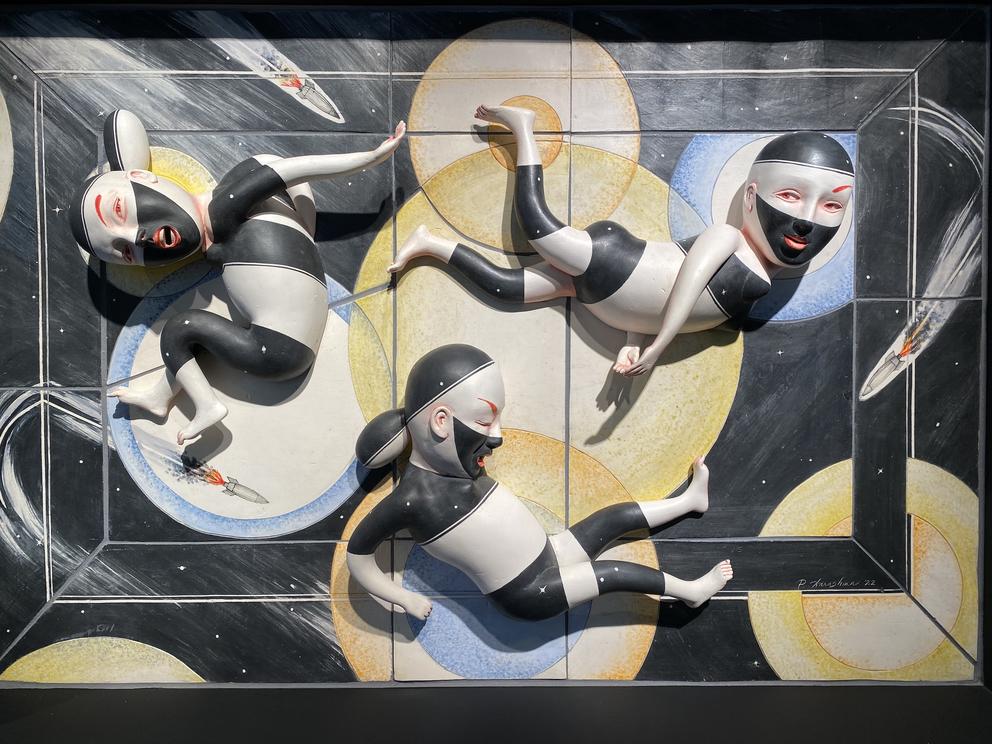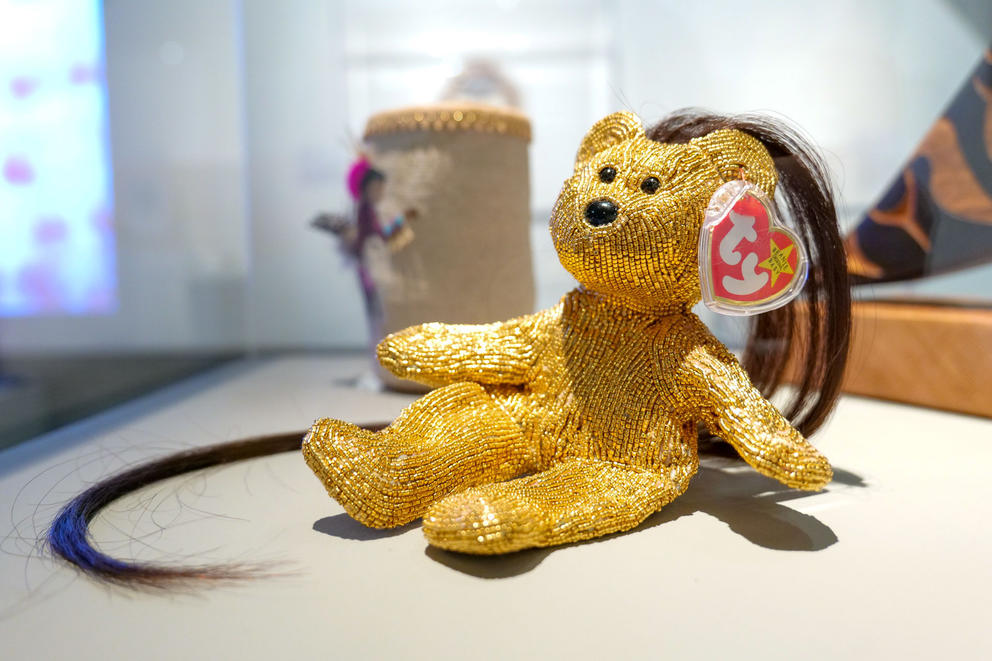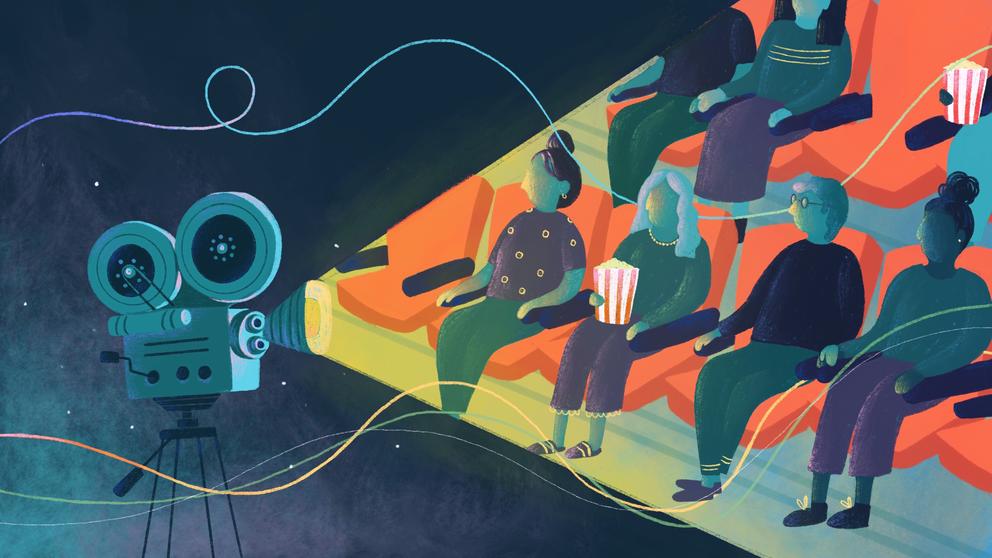The show, The World Upside Down (at Traver Gallery through Sept. 2), came to mind when I started seeing the devastating images from the Maui wildfires this week.
With our now-customary “smoke season” in the Pacific Northwest, we have plenty of tangible evidence that climate change is upon us. Yet with all this terrible substantiation, it can still seem as if we’re watching our planet at a remove.
Is it a coping mechanism, denial or acquiescence?
Warashina, born in Spokane and always expanding her 60-year art career, frequently uses her work to explore the curiosities of the human psyche.
“These figures have become the actors in my introspective narratives,” she says in her artist statement, “... a way of escaping the doubts and disharmony of human nature … by role-playing scenarios to my liking, much like a child playing with dolls.”
Her clay figures, painted in striking primary colors, black stripes and constellations, tumble around the burning earth in pieces named “Hot Seat,” “Explosive Situation” and “We’re Outta Here.” Some scenes include etched imagery of rockets, rifles and encampments. In one, a garden hose flails against the flames.
ArtSEA: Notes on Northwest Culture is Crosscut’s weekly arts & culture newsletter.
“To me, the figures represent human consciousness,” Warashina writes of the series, “observing and experiencing the realization of possible escape from annihilation portrayed through dreamlike, cosmic scenarios using current and future space technology.”
Now 83, Warashina is known for both her political themes and her sense of humor. So while the topics may be deadly serious, her approach is ever playful — in this case including a few “cosmic cats” holding planets of their own. “Humor can be a protective thing,” she recently told The Seattle Times. “Art and humor can keep us from going over the edge.”
If a little humor could help keep you from going over the edge, head to Georgetown for a new exhibit by internationally acclaimed brothers Einar and Jamex de la Torre. Called TERRIcolas (EARTHlings) (at Koplin del Rio gallery through Sept. 2; artist walkthrough Aug. 26), the show features the duo’s unmistakable blown and flame-worked glass pieces.
Here too, humanoid figures respond to the environmental crisis — some of them, including “A La Diabla” and “Schedule Conflict,” appear to be on fire. Other earth inhabitants seem to have evolved into something new: “Charmer” has pink antlers, and legs growing from its shoulders. In “Yoga in Sedona,” a scorpion sports a robotic face and a green mohawk hairstyle. “Adonde Vas Corazon?” is a heart that has sprouted a face, legs and arms.
The pieces are kind of freaky. But that’s the Guadalajara-born brothers’ specialty as they combine cultural references (Catholic iconography, Slavic mythology, American pop) and meld glass with cheap plastic baubles. Using a style they term “multilayered baroque,” these artists critique the hubris of disregarding nature and the ecological crisis.
"The moment in history we are living sorely calls for true humility,” the de la Torres write in their artist statement. “We’re terricolas, we’re just termites in our planetary mound and need to balance our consumption for the sake of simple existence.”
Tlingit artist Alison Bremner is another Northwest artist who weaves wit into her artwork. You may recall her 2014 piece “’Wat’sa with a Pearl Earring,” in which she added a Tlingit mask to the classic Vermeer painting as a critique of the lack of Indigenous art in the visual-art canon. In other pieces she has used traditional formline design to depict everything from the Hale Bopp comet to Burt Reynolds to a cat lady.
In late July, Bremner won two artist awards from the Washington State History Museum as part of the annual In the Spirit showcase of contemporary Native arts (through Sept. 24). Her piece “Millenium Dreams” — for which she spent countless hours sewing 24k gold beads (and human hair) on a Beanie Baby bear — earned both the Honoring Innovation and the Purchase Prize and will be added to the permanent collection.
“The feverish and insatiable quest to collect Beanie Babies meant that children had a hard time finding the toys,” Bremner said in her statement, “just as the equally feverish quest to collect Tlingit sacred items has led to this point, where human remains and sacred objects are housed in museum collections, far away from their home communities, their intended context.”
Visit the show in Tacoma on Saturday and you can also experience the popular In the Spirit Arts Market and Northwest Native Festival (Aug. 12, 10 a.m. - 5 p.m.), featuring live music, the Alaska Kuteeyaa Dancers and lots of Indigenous vendors showcasing arts, jewelry and apparel.
And there are plenty more regional festivals on deck, for those who feel like giving humanity a hug this weekend...
For the second year, Vashon Island is bringing back the Vashon Island Film Festival (Aug. 10-13), showcasing feature films, documentaries and shorts. Included in the lineup are two music docs of note: Clyde Petersen’s Even Hell Has Its Heroes, about Seattle band Earth, and Boom: A Film About the Sonics (the influential Tacoma rock band, not the basketball team!).
In Tacoma, GlassFest Northwest (Aug. 12, 10 a.m. - 5 p.m.) celebrates the art form with live glassmaking demos, art-glass vendors and free admission to the Museum of Glass, where I recommend the current show She Bends: Redefining Neon Legacy (through Oct. 29).
On Bainbridge Island, the self-guided Summer Studio Tour (Aug. 11-13) showcases a wealth of local artisans — painters, jewelers, wood carvers and more — and their creative environments.
In Seattle, the Wing Luke Museum is holding its annual Hai! Japantown celebration (Aug. 12, 1 - 5 p.m.), an all-ages block party featuring DJs, a Butoh dance demonstration, food booths, Taiko drumming and a music set by indie rocker Tomo Nakayama.
And at Seattle Center, the Day In Day Out music festival (Aug. 12 - 13) brings a slew of bands and DJs to the Fisher Pavilion, including headliners Leon Bridges and Bon Iver and local fave Enumclaw.
Get the latest in local arts and culture
This weekly newsletter brings arts news and cultural events straight to your inbox.







